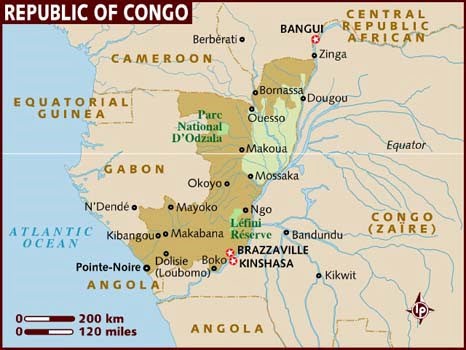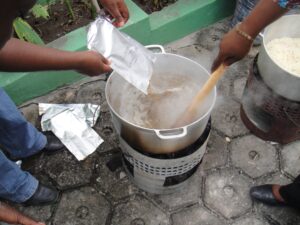Global Food Aid Case Study: Congo Republic


Seafood powder: building the evidence with pilot projects in Congo Republic (Brazzaville)
The Alaska Salmon Powder Pilot Project was initiated to meet the consumer demand and desire to provide a highly nutritious form of Alaska salmon to those in need of the vital nutrients within this product, without shipping cans. It can be provided with or without added fortification and used as an ingredient in cooking or added to other foods.
The Salmon Powder was tested among consumers in food aid programs in Guatemala, the Republic of South Africa, Ghana, Nigeria, Mozambique, and the United States before we had the opportunity to pilot test it in Congo Republic. This pilot is the first to include Alaska salmon powder in school meals in Africa to test its acceptability and get consumer feedback. ASMI’s Global Food Aid Program (AGFAP) partnered with International Partnership for Human Development (IPHD) to pilot test the salmon powder in school lunches among about 5,000 students in six grade levels, ranging from age six to sixteen and school staff in primary schools. The project took place in eight primary schools in Brazzaville, the capital, and the nearby rural region of Pool.
The Alaska Global Food Aid Program worked with local staff, government officials, school principals, teachers, and cooks to develop recipes, train in the procedures and protocol, set up distribution, and collect baseline and later, endline data. All the schools received monthly distributions of salmon powder, along with beans, potato flakes, and rice. School cooks prepared two different recipes enhanced with the salmon powder which was served four or five days per week, depending on school location. The powder improved the nutritional quality and taste of school meals.
 In this pilot project, salmon powder was successfully incorporated into a USDA-funded Food for Education school lunch program, and could be used similarly in other countries. The product’s light weight and streamlined packaging simplified its storage and distribution. The resealable, shelf-stable sachets are practical and easy to handle, according to IPHD and school staff. It was easy to prepare even with limited cooking equipment. The children and staff gave the powder high marks. Questionnaires which rated the taste, odor, and presentation of the powder enriched meals yielded positive results. 83% of children would eat the salmon powder again enthusiastically.
In this pilot project, salmon powder was successfully incorporated into a USDA-funded Food for Education school lunch program, and could be used similarly in other countries. The product’s light weight and streamlined packaging simplified its storage and distribution. The resealable, shelf-stable sachets are practical and easy to handle, according to IPHD and school staff. It was easy to prepare even with limited cooking equipment. The children and staff gave the powder high marks. Questionnaires which rated the taste, odor, and presentation of the powder enriched meals yielded positive results. 83% of children would eat the salmon powder again enthusiastically.
Flavor was the strongest predictor of overall rating. Participants described the taste as “citrusy” and “rich.” At the end of the first semester, there was enough product left to continue for another semester with similarly positive results. Next generation of this product and new forms of this powder will provide the opportunity to provide all the protein they need every day. The powder is a great dry ingredient on its own or as a vehicle to enrich with minerals like iron and zinc and other micronutrients for treating and preventing these deficiencies. The next generation powders will have a very mild flavor profile so they can be used in baked and prepared foods to deliver protein where little or none is normally available. We will be testing locally baked protein and micronutrient-enriched biscuits in our next set of trials in Guinea-Bissau. Stay tuned…
THE FUTURE of SALMON/SEAFOOD POWDER: Given the lessons learned from the Alaska Salmon Powder Pilot Project in the Republic of Congo, research and development is focusing on a next generation powder that will supply even a higher level of protein and be more versatile as an ingredient or carrier of other nutrients. According to the country representative, the salmon powder could be a viable commercial product in Africa, similar to fish or shrimp powder used as a soup base and flavoring throughout the continent (Cristian Balan, IPHD 2014).


